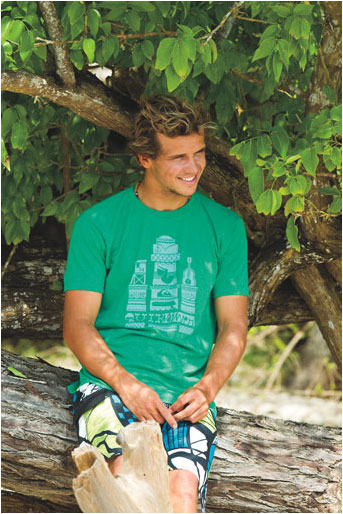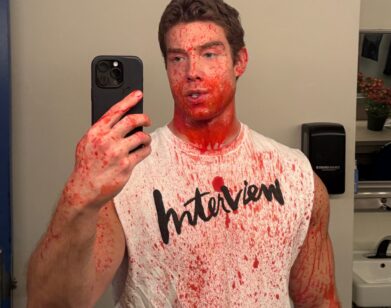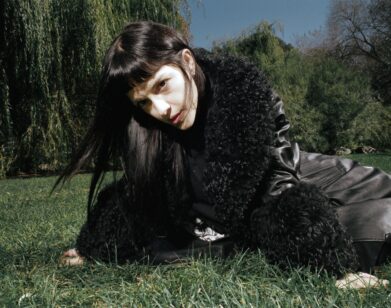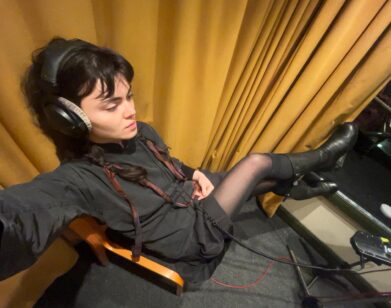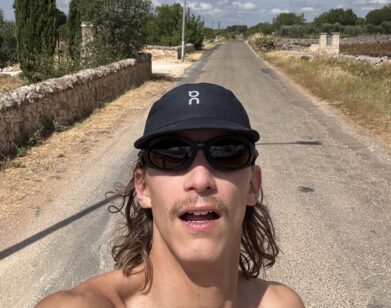The New Wave
Australia’s Julian Wilson is the new new thing in competitive surfing. But before he made his jump to the pros, the 21-year-old Queensland native took a year off (with a posse of mates, including American shredder Ian Walsh and his Aussie mentor, Taj Burrow) to surf his way around the world. Of course, if you’ve been sponsored by Red Bull and Quiksilver since before you can drive, taking a year off to surf means hitting the waves, camera crew in tow ,shooting some of the most cutting edge footage (via the ultra hi-def RED, Phantom, Cineflex heli-cams which made those migration scenes in Planet Earth so epic). The resulting footage is the Irons Brothers produced surf doc, Scratching The Surface, which just came out on DVD. Though the soundtrack is great, the interviews are pretty sparse, so we talked to Wilson, Walsh, and Burrow for a little taste of what it’s like to continually surf your way around the world (and get paid while doing it).
SLENSKE: What’s the most important thing an aspiring grommet should take into
account if they want to become a surfer?
WALSH: You are the future, push yourself… and never pee into the wind.
The New Wave
Australia’s Julian Wilson is the new new thing in competitive surfing. But before he made his jump to the pros, the 21-year-old Queensland native took a year off (with a posse of mates, including American shredder Ian Walsh and his Aussie mentor, Taj Burrow) to surf his way around the world. Of course, if you’ve been sponsored by Red Bull and Quiksilver since before you can drive, taking a year off to surf means hitting the waves, camera crew in tow ,shooting some of the most cutting edge footage (via the ultra hi-def RED, Phantom, Cineflex heli-cams which made those migration scenes in Planet Earth so epic). The resulting footage is the Irons Brothers produced surf doc, Scratching The Surface, which just came out on DVD. Though the soundtrack is great, the interviews are pretty sparse, so we talked to Wilson, Walsh, and Burrow for a little taste of what it’s like to continually surf your way around the world (and get paid while doing it).
MICHAEL SLENSKE: You’re a hard man to get in touch with.
JULIAN WILSON: I am? Yeah, I’ve been pretty busy.
SLENSKE: Where you been?
WILSON: I’m in France now, but I’ve been driving. I drove down to Spain and flew up from Portugal into France and kind of been all over the place.
SLENSKE: Are you surfing in all those places?
WILSON: Yeah. In Portugal I went to an island, it’s like a two-hour flight, called the Azzores. But the waves were really abysmal out there. The event didn’t even run that I went out there for, so that was no good. France has some fun waves, the southwest of France.
SLENSKE: So how did the movie come together?
WILSON: I was coming off of my junior career. I was 20 and instead of jumping on to the WQS, which is what I’m doing now traveling around the world doing these events, I kind of wanted to take a year off and make a movie because that was a really good opportunity to do it because this was probably the only time in my career when I could take time off and doing something cool like this.
SLENSKE: Have you always been traveling with this group of guys?
WILSON: No, I travel by myself a lot. Most of the time I’m by myself. During the movie I was always traveling with at least a filmer, then there was a bunch of trips where I brought a few surfers along.
SLENSKE: So you don’t really have an entourage that follows you?
WILSON: No, not at all. Especially like this year I’m doing it mostly by myself, travel to events, meet up with people I know there, then travel to the next event. Last year was the full entourage. It’s definitely a lot easier to get around this year.
SLENSKE: Is it hard to surf when you’ve got helicopters and guys in the water and boats?
WILSON: Yeah, at first when I started filming it was a bit stressful and overwhelming and that demand to pull of your maneuvers or whatever, but as the project went along I got more comfortable with it and it became a lot easier.
SLENSKE: What’s one of the greatest memories from the trip?
WILSON: One of the best places we went was South Afirca. We didn’t get the best waves, but all the local people and the culture was just amazing. I had a blast. It’s too bad the waves weren’t as good as they were meant to be, but it definitely made up with the people there. It was great to check out the game park and the wildlife in Durban. Last year I was doing that a lot. We’d go to a country and post up for at least three weeks at a time. In that three weeks there were definitely windows where the waves weren’t good.
SLENSKE: Did you always think you’d be a pro surfer?
WILSON: Yeah, I have two older brothers and mum and dad, they all surfed, and I was pretty much thrown on a surf board when I was out of nappies and walking so it wasn’t until I was about 15 or 16 that I was starting to get some proper money for it and stuff and realizing I was going to be able to do something I love for the rest of my life. I didn’t have to really work for it that hard it was really just a natural progression of doing what I love doing and then being good enough for it to help me out financially. I was just pretty lucky.
SLENSKE: Your style, especially that sushi roll move, is based on a lot of aerials and carving. You didn’t start out that way, did you?
WILSON: Well, growing up I watched a lot of surf films. My two older brothers always had surf films on, like Signature Films back then like Taj Burrow’s Sabotage and Montage and Kelly Slater’s Black & White and the Irons brothers had Raw Irons. Those movies are what I watched day in and day out and tried to surf like and Taj is probably the main guy I was looking to surf like.
SLENSKE: Well, he was the first one to do that kind of stuff.
WILSON: Yeah, Sabotage was like the first hard core surf performance memory in my mind. I watched that film until it was dead.
SLENSKE: So were you ever on a longboard just cruising waves?
WILSON: Yeah, my brothers and mum and dad, they all ride longboards. I’d always ride a long and a short board growing up. I won an Australian title on a longboard, but I kind of got bored with that when I hit the 15, 16 mark. It was a lot more competitive and I could surf where there was money and traveling and a lot more going on.
SLENSKE: Judging from the way things are going, the tricks will have to get more difficult. What could you do now that you aren’t doing?
WILSON: There’s always going to be different grabs, but the next progression, I think, with aerials is probably going to be doing more rotations, which is pretty damn difficult but I definitely think the potential is there. If you get the right wave and the right section on that wave and someone will be able to spin around more than once and that will be pretty groundbreaking for surfing.
SLENSKE: What about flips?
WILSON: Guys have been doing flips for the last two years but it’s not the most functional maneuver and it takes a lot of tries to get one, so if you try that for a whole surf you just kind of sacrificing the whole session. I think it’s also coming to doing more than one maneuver on a wave. It’s about doing the big airs and the big turns and getting barrel in the same wave and that’s what people want to see, linking a whole wave together. The flips are cool, though, and if you can get a couple of those in your movie it’s insane, but the rotations are what people are really looking for, to get that extra 180 out of a spin.
SLENSKE: What’s the biggest wave you’ve ever surfed?
WILSON: Probably about 12 foot. I haven’t really surfed the biggest waves. Surfing those big waves, it takes time and dedication and training chasing those swells down. It’s hard because you call a wave 12 foot because that’s just how surfers call it, but for someone on the beach the face of the wave might be 20, 30 feet so they think it’s that big. But I’ve surfed some pretty big waves.
SLENSKE: Have you ever been really smashed by one of those waves?
WILSON: You get those moments a lot in Hawaii, but I’ve never had any where I’m like, “Not going to make it through this one.” I don’t have any real bad ones. I had a wipeout at a place called Sunset Beach and I came up and I couldn’t see and I thought it could have been the end but I never blacked out. I’ve been scared, but no heroic blackouts.
SLENSKE: So how do you manage to always pull off those spins?
WILSON: It’s just pretty natural, it’s just a feeling. Every wave you catch is different and you just have to read it for what it is and go with it.
SLENSKE: Gotcha. How’d you pick the soundtrack for the film? It’s really great.
WILSON: That was me and Matthew [Beauchesne], the guy who put it together. We worked together pretty closely on that. Me and Matt have pretty similar tastes in music and we wanted to bring variety to the film and make it fun and enjoyable.
SLENSKE: It makes the film faster than a lot of surf films. More action.
WILSON: Yeah, we just wanted to make something that was fun to watch, not something where you start scratching your head looking around the room. We wanted to keep the lifestyle very eyecatching and cool.
SLENSKE: Is the lifestyle just all girls, lighting fireworks off boats, and hopping planes from one beach to the next?
WILSON: [Laughs] Um, yeah. There’s a guy who comes on every trip with me with the RED camera and the 70 to capture all that stuff. He gets the giraffes and lions in South Africa, in France filming all the old streets, and every other thing that’s going on around the trip. I think that helps a lot with bringing people along and making them interested in the lifestyle I get to live.
SLENSKE: So where do you want to surf next?
WILSON: I went to Japan a few years ago called Miyazaki, and I really want to go back. You have to go during typhoon season to get the big waves.
SLENSKE: Are you pushing to win a World Cup?
WILSON: For sure. The movie was a chance for me to take a break from competing, refresh, and get motivated and get that fire back in me to compete and that’s what I wanted to do.
IAN WALSH
MICHAEL SLENSKE: How did you get into surfing?
IAN WALSH: My dad was a surfer and growing up with so much time at the beach on Maui it was inevitable that I would pick up a surf board at some point. I learned at Ho’okipa Beach on the North Shore of Maui and grew up surfing all over the island on an old beat-up Blue Hawaii board my dad and uncle shared. Looking back at that thing is classic! Makes me laugh a little and really appreciate the equipment we now.
SLENSKE: What was the turning point that made you want to go pro?
WALSH: Seeing the older guys like Matt Kinoshita, the owner of Kazuma Surfboards, and Shane Dorian, get to travel around the world and see so many different places and surf so many different waves. being a surfer was my biggest goal from when I was about 14. Matt really paved the way for me by making my surfboards from the very beginning and helped drag me out into some really solid surf at young age, starting my love for bigger surf. I grew up surfing with Matt all the time and learned a lot just from being in the water with him. He would take me surfing all the time, a big part of my surfing now is my three younger brothers as well, Luke, Shaun, and D.K. They pushed me at everything we did. and shane, I always looked up to as an idol and i was lucky to get to surf with him in my later teens and for the last seven years or so he has been one of my closest friends and is still one of my biggest influences. I remember the first time Matt took me out to surf a really big out reef for a paddle session when I was about 15 and with in the first half hour I got caught inside on a massive set and broke my board in half and drug all the way to the end of the waves then had about a 40 minute swim into the beach. Matt has been helping me develop and modify all my boards for Jaws to help progress our sport. I’ve also had countless amazing days with Shane over the last few years being tow partners, but the funnest trip we’ve done was a snowboard/surf cross-over trip we in Chile with two pro snowboarders. We were so excited to just get out of the surf and into the snow and the waves were pumping the first few days so we were locked into the ocean. We broke five boards each in two days then were all smiles knowing all we could do now with no boards was snowboard!
SLENSKE: At what point do you stop being a grommet?
WALSH: Not sure, that varies… I would say when you start to help younger kids and look out for them.
SLENSKE: You ever work a regular job before going pro?
WALSH: Not too many luckily. [LAUGHS] I did roofing for about two weeks to help a friend’ dad out in high school and at the end of those two weeks i was looking down at my torn up hands and decided right there that I am putting everything I have into surfing. that really motivated me.
SLENSKE: What’s the best thing about being a pro surfer?
WALSH: Being in a very small group of people that are doing what they love for work. basically I am doing what i would do even if i wasnt doing it for a living, I would work all night just to be able to surf when the waves are on.
SLENSKE: If you watch Scratching the Surface, and many of your films, it seems like the life of a pro surfer is basically just one traveling party. Anything you’d like to add to that?
WALSH: There is a lot of those things and we do like to have a good time, but don’t be to naive, there are tons of extremely talented surfers all over the world that would kill to be any one of our shoes so a lot of hard work goes into progression and surfing our best.
SLENSKE: What’s the biggest wave you ever surfed?
WALSH: It was at jaws. I think it measured out to about 69 feet, and the heaviest wave I have ever ridden was at Teahupoo, Tahiti. Math is difficult when something is moving.
SLENSKE: What’s the scariest moment you’ve ever had surfing?
WALSH: Consciously realizing I am blacking out from being held under too long and
understanding that i am completely at the mercy of the wave at that point. This has happend twice, once in Japan on one of the biggest typhoons they have had in like 30 years and the other was the same day as the tall wave I rode at home on Maui at Jaws.
SLENSKE: What happened?
WALSH: At Jaws I had been having a really fun day and felt like I was pushing myself and I was starting to get really comfortable and as I let go of the rope from the jet ski that towed me in and I caught and edge on my board, slowing me down a ton before I even dropped into the wave but I was already committed so I made the drop and when I got to the bottom I realized I was a little too deep and I was aiming at pulling into the barrel and as I set my line the wave started to shut down and as I tried to changed my line the lip of a 60 foot wave landed right on my neck and blew the life jacket I had on apart and it was dangling around my head as I got sent down and started to fight to swim up, when the wave hit me it knocked the wind out of me to add to the whole situation, then as I was thrown around like a car accident, trying to hang on to the life jacket and swim up, I opened my eyes like usually do when I am under for a long time to gauge how far from the surface I am. And when it should have been a bright white all I saw was the darkest scary black I have ever seen. At the same time I could feel my whole body starting to cramp all the way to my finger tips from the lack of oxygen, and while I am telling my self to swim and fight to the top my arms start to stop reacting to what my brain is telling them and then boom! I pop up, get a breath quickly and come completely back to consciousness. I only got that tiny breath in before getting nailed by the next wave in the set and getting blown back under. I guess when I popped up right then there was a jet ski that came to help but made eye contact and waved them away and said I was fine, but I have no recollection of seeing the guy or waving him off at all. I came to the conclusion that seeing the pitch black was me about one-tenth away from blacking out completely.
SLENSKE: What’s the most important thing an aspiring grommet should take into
account if they want to become a surfer?
WALSH: You are the future, push yourself… and never pee into the wind.
TAJ BURROW
SLENSKE: What’s your earliest surfing memory?
BURROW: I’ve been on the beach since I was a grub. My parents would take turns looking after me while the other one surfed, so I guess I was always destined to be a surfer. I was seven the first time I stood up on a wave. It was on my old boy’s oversized raft at Yallingup in West Oz. At the time I thought the wave was huge but it would have only been a few feet.
SLENSKE: When did you realize you’d pro?
BURROW: I never pictured myself being a pro, I just wanted to surf everyday and do airs. I pulled on my first contest singlet when I was nine, won the first few local comps I went in and caught the bug. I’ve competed ever since.
SLENSKE: A lot of reporters say you’re the best surfer never to win a world title, and it was reiterated in Step Into Liquid. Do you even care about winning one?
BURROW: God I hate that tag line. Yeah, I care, I wouldn’t still be on tour if I didn’t, but it’s not most important thing to me anymore. My focus has changed a lot in the past 12 months. I use to put all this pressure on myself, study the ratings and know exactly how many points I needed at certain events, it was such a head fuck. Right now I’m having the time of my life, travelling the world, going mad and trying to win as many events as I can. I couldn’t be happier.
SLENSKE: If you watch Scratching the Surface, and many of your films, it seems like the life of a pro surfer is basically just traveling to exotic places, partying (shooting flare guns at neighboring surf boats), beautiful girls. Anything you’d like to add to that?
BURROW: Nah, you pretty much nailed it on the head. It’s a wild ride at times and I wouldn’t change it for anything, I’ve definitely got the best job in the world. I don’t take it one bit for granted.
SLENSKE: Did you ever have another job before you went pro? What were you doing?
BURROW: Nope, I’ve been surfing professionally since I was 15 and luckily I managed to make a career out of it fairly early. My parents made sure I finished high school for something to fall back on but I didn’t need to. I wanted to be a Pilot when I was a Grom, which is strange considering how much time I spend on planes now.
SLENSKE: What’s the best place for catching waves?
BURROW: I’m away about ten months of the year and I spend my spare time in Bali these days, I only get back to where I grew up for around three weeks over Christmas. West Oz has some of best waves for sure, Indo is unbelievable and Hawaii is right up there with my favourite spot. I’ve ticked a heap of countries off the list but I’ve still got a few I would like to check out.
SLENSKE: How long have you been traveling with this group of guys?
BURROW: The guys on tour? It changes every year. I’ve been on tour for 12 years. Julian, Dusty and Dane are a bit younger than me, I’ve only been hanging with them for a few years.
SLENSKE: You always hear stories about wave enforcers on certain beaches. You ever get into a fight over a wave?
BURROW: Hawaii is about the only place I have had any dramas but nothing major, I’ve never had to throw fists on the beach or anything thank god. I’ve seen a couple of mad scraps over the years though. I try and keep a pretty low profile in most places, you need to respect the locals and just take your turn.
SLENSKE: What’s the biggest wave you ever surfed?
BURROW: I’m not really a mad tow guy or anything but maybe around 20ft in West Oz. It was actually super fun getting whipped into these huge fat burgers with my survival stance on.
SLENSKE: What’s the scariest moment you’ve ever had surfing? Where? What happened?
BURROW: I was surfing this reef slab in west oz when I was younger with only a few out, it wasn’t a huge day but super shallow. This guy went over the falls on one, hit the reef and came up screaming, we got him to the beach on a surfboard and lifted him up the cliff face to where the cars were parked. We were in the middle of nowhere, about 40 minutes of rough 4WD track and then another 20 minutes to the Hospital. He was just screaming that he couldn’t feel his legs, It turned out he had severed his spinal cord and would never walk again. That really spooked me, just to see how quickly it could happen. I still see Grant around occasionally, he is the most positive guy, he’s part of the reason I’m involved in the Disabled Surfers Association in West Oz.
SLENSKE: What’s the most important thing an aspiring grommet should take into account if they want to become a surfer?
BURROW: Surf every day, no matter how bad it is. Oh, and try and look good when you’re going straight.

